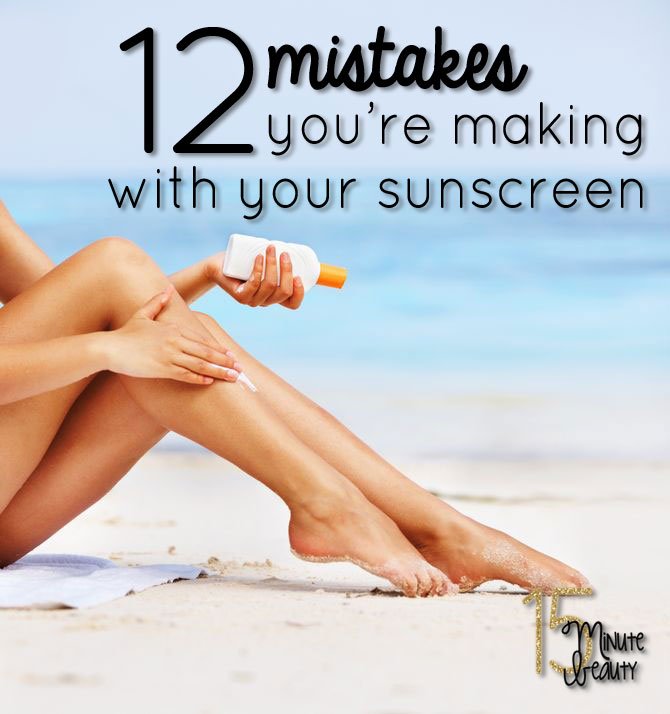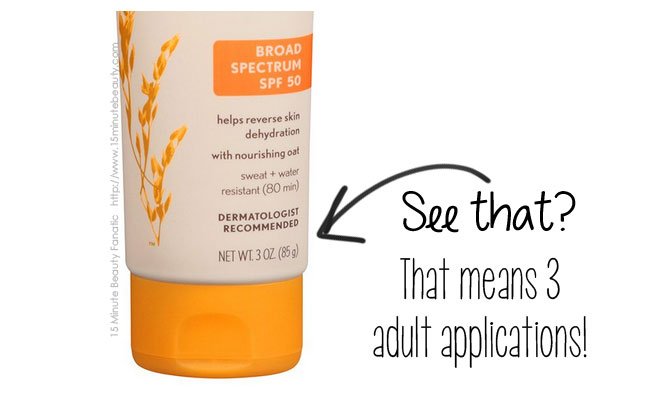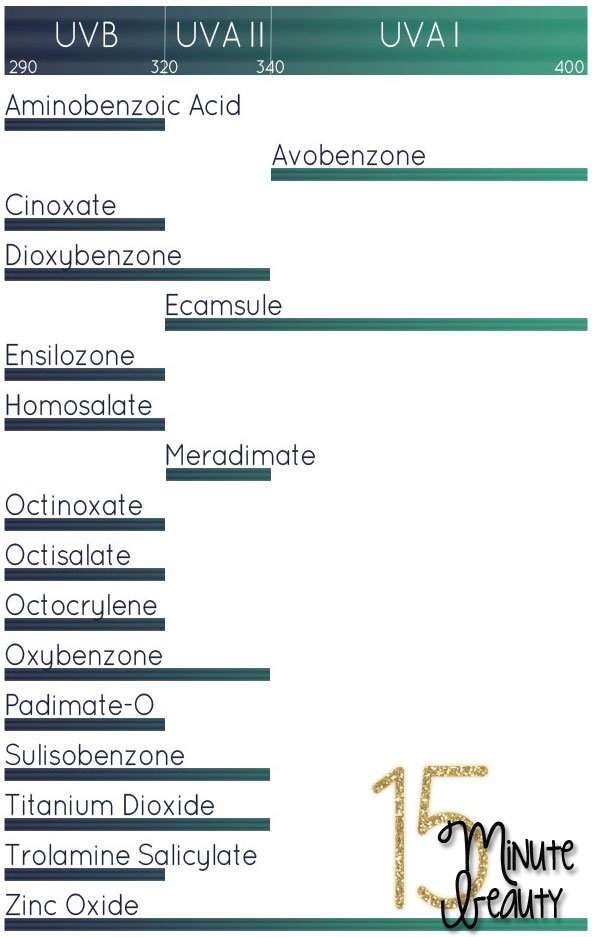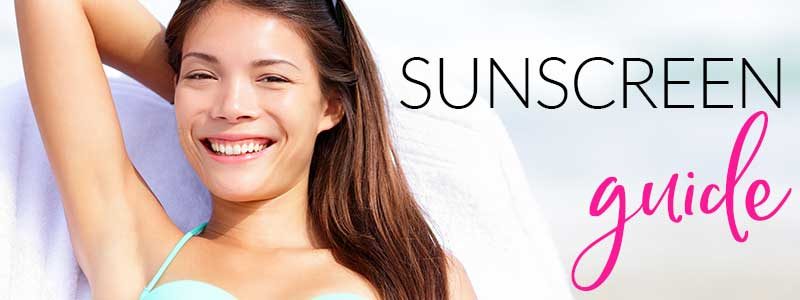I’ve written a lot about sunscreen over the years, with good reason. It’s the #1 thing you can do to prevent damage to your skin, the largest organ in your body. That damage can result in cancer, but more superficially (and this is a beauty blog after all) who wants to deal with sunburn, freckling and hyperpigmentation and further down the road more photodamage induced aging? Not me!
Even if you have the best of intentions, chances are that you’re making at least one of these 12 sunscreen mistakes. Take notes!
1. You’re not using enough
That SPF number on your sunscreen bottle isn’t just randomly picked or calculated based upon some equation. It’s tested on real people in a set environment, and one of those set parameters is that the sunscreen is applied to be 2 mg/cm2 of skin surface area. That is a lot of sunscreen. For that average adult, you’ll need 30 mL (1 ounce, or a shot glass) of sunscreen
As a general rule:
• 1 ounce (30 mL) = 1 application to body
• 1 tsp (5 mL) = face
2. You’re Not Reapplying
So, the way that most sunscreen ingredients work (except for Zinc and Titanium Dioxide) is that they actually change their chemical shape when hit by the sun. This absorbs or bounces off the UV radiation before it can affect your skin, but it also inactivates the sunscreen. To keep this up, you need to reapply to make sure you have plenty of active sunscreen around. As well, sunscreen melts off (anyone ever sweat into their eyes while wearing sunscreen? OUCH!) so you’ll need to replace what’s displace.
Most dermatologists recommend reapplying your sunscreen every 2 hours. If you’re using the correct amount that means the bottle you bought for your beach vacation should last 3 applications or 6 hours in the sun, not an entire season.
3. You don’t use a high enough SPF
Most dermatologists recommend using at least SPF 15 everyday, though most would prefer SPF 30 (or even higher if you have a lot of sun exposure, are particularly fair skinned or have a history of skin cancer in yourself or your family). There are quite a few of us that usually buy right at that level and think we’re “being good.”
In truth, because so few of us are using the correct amount of sunscreen (let alone applying it), you aren’t getting the SPF value you think you are getting out of your sunscreen. In fact, you’re probably getting about 20-50% of the SPF value you purchased (study). As a general rule of thumb, many dermatologists use 30%. So, your SPF 30 is roughly a SPF 10 if you’ve applied it like most people.
Instead, you should buy the highest SPF you can stand to put on your skin and still use it!
4. Your sunscreen isn’t full UVA/UVB Spectrum Coverage
I have definitely been guilty of this one! Until fairly recently, a company could label a sunscreen as broad spectrum whether it was true or not. The typical consumer had no real way of knowing. With the new sunscreen labels in place in the US there are set standards for broad spectrum. (Read more about what is on a sunscreen label and how to read it).
While the new guidelines are better for deciding if a sunscreen does in fact cover both UVA and UVB rays, it’s possible to have UVAII rays not covered. I recommend checking your sunscreen for the active ingredients and then comparing to this chart of sunscreen UV coverage. I obtained the spectrum coverage information from the FDA, this is everything currently approved for use in the US. Print off a copy or carry it in the photos on your phone (which is what I do)!
5. You think that waterproof and sweat proof really = waterproof. It doesn’t.
So, back in those new sunscreen label guidelines that the FDA put out, they fixed the whole waterproof/sweatproof thing. It used to be that neither term really meant anything since they didn’t have to be backed up. Instead, you’ll now find “water resistant” at 40 minutes and “very water resistant” at 80 minutes (read more about how the waterproofing in sunscreen is tested).
Even if you go swimming for 10 minutes and your sunscreen is water resistant, you should still reapply after getting wet.
6. Your sunscreen is older than your flip flops
Yes, it outdates! Toss it after a year. The easiest way to keep track is to just write the date you opened the bottle on it with a sharpie.
7. You miss spots
We’ve all been there. You come home from the beach to find that you have a strangely shaped burn right in the middle of your back.
That is much less likely to happen if you apply your sunscreen inside, at home, before putting on clothes. You can contort yourself however you want to reach that spot in the middle of your back, and since your bikini isn’t there to get in the way, you won’t be worried about getting sunscreen all over it and miss a big area around the straps.
Easily forgotten areas: The tips of your ears, the part in your hair and the backs of your hands.
8. Your sunscreen doesn’t have time to start working
This problem is also easily helped by applying at home before you get ready to head to the pool. Chemical sunscreens need 15-30 minutes to “set” and be fully absorbed into the skin before they’re fully effective. Physical sunscreens don’t need this extra time, but you should still apply before exposing yourself to the sun. (More about the difference between a chemical and physical sunscreen.)
9. Don’t use it everyday
Most people consider themselves sunscreen users if they wear it once every 1-2 weeks at the beach.
get exposed every day! UVA can travel through glass!
10. You have been relying on your makeup to give you daily sun protection
While it is true that the pigments found in much makeup (especially foundation) has some natural sun protection by acting as a physical sun screen, you probably aren’t using enough of it to really protect your skin. Remember the 2 mg/cm2 that a sunscreen needs to be for testing? That means you need to put about 5 mL (a teaspoon) of foundation over your entire face (which you likely aren’t doing). Powder is even worse, you need 1.2g of powder for the average face, which is about 30-50% of the entire product typically. Most women apply 0.085g (1/14th what they need to get the advertised SPF).
You’re much better off relying on a product that you do apply in the appropriate amount and location for your sunscreen. I usually use a SPF lotion each morning or apply a separate sunscreen. Anything I get from makeup is considered a bonus.
11. Don’t forget your lips!
Yes, they do burn. The lips have less protection than the rest of your skin, and it can be very painful when they are burned! Wear sunscreen lip balm
12. You’re not using sunscreen!
Just because you apply sunscreen when you’re heading outside to the beach or pool doesn’t mean you are a good sunscreen user. Multiple studies have found that correct and daily use of SPF 15 is better for your skin (aka- less damage is caused by the sun) than intermittent use of a much higher SPF.
So, apply every day and increase your SPF value during peak sun hours (10am-2pm) and high UV index days.
I haven’t even touched on using UPF clothing, window shields, or other ways to protect your skin from the sun. Which of these have you been doing wrong?






 I’m a doctor, a mommy and a bit of a beauty addict. If you let me, I can take 2 hours to get ready in the morning. Really. I'm on a quest for faster beauty that works!
I’m a doctor, a mommy and a bit of a beauty addict. If you let me, I can take 2 hours to get ready in the morning. Really. I'm on a quest for faster beauty that works!
Hi – thank you very much for this post, particularly the little chart with the various sunscreen ingredients! I actually printed that off and have saved it on my hard drive – it's that useful and important! I know I've always liked zic ox – my skin just likes it better than avobenzene, but now I'm curious about the ecamsule…. It's pretty new to the states, isn't it? Will have to look for ones that have that as an ingredient and check it out!
Thank you again for a very important post! My DH had melanoma on his arm a few years back, but fortunately, Mohs surgery was all that was required to take care of it, and now I nag the bejeezus out of him to wear sunscreen! 🙂
I have been a lurker on your blog for a long time and just wanted to comment on this very important subject. Have a wonderful weekend!
While I'm aware that zinc/ titanium oxides provide a barrair against UV rays/ pollution, would you agree that you needn't reapply such products every 2-3 hours?
I do use more than a tsp for my face, but I always wonder if it's enough. Mineral sun blocks are not the most pleasant to reapply.
Thanks!
This is a great post! I used to be guilty of missing spots until I started applying at home before putting clothes/bathing suit on. I also find that using a spray helps to make sure you don't miss any areas!
What a fantastic post!!! Thank you!!
Thanks for the sunscreen chart. This is always a good reference to use when buying sunscreens. So many chemical sunscreens that I look at don't bother to protect the skin from UVA II rays.
However, I usually just look for over 10% Zinc Oxide in my sun screen. I know that I will have total protection then. But it does take a while to get a teaspoon worth rubbed into my face and neck.
@anon
Most derms still recommend reapplying every 2-3 hours even with a physical sunscreen due to sweating, inadequate application (though that isn't an issue for you), etc.
This is just the best article ever. I'm very impressed. You taught me a lot and I'm definitely bookmarking it to help me pick out sunscreen in the future.
I would love a post on how to make sure you can stay properly covered with sunscreen all day while keeping your makeup in place! We used spray sunscreen last year but got burned really bad because half of the mist blew away in the wind and we didn't even notice.
Also, what are the best baby sunscreens?
Yes one thing I did not realise was that sunscreen has an expiry date, but I learnt that the hard way. Sunscreen is so important I live in a country that melanoma is high so I put sunscreen on before I head out for the day and then every few hours. I also love the spray although I dont think its as effective as the cream, but that is my personal thoughts
EXCELLENT POST. Many thanks!
Sara
Ooh can you add the Tinosorbs and Mexoryl XL to your chart? It is SO helpful and eye opening!
Thank you! One question I hope you can help with – I used to read the skincare board at Makeup Alley and eventually my brain melted down with all of the opinions about how certain makeups, on top of sunscreen, undermine the sunscreen and reduce its SPF or its effective time. I'm a smart person but I need a sunscreen and some makeup coverage – if it takes me hours to sort through the conflicting ideas about X reducing the efficacy of Y, eventually I'm going to give up and quit reading. Is this all bunk (or, even if it isn't, aren't we better to use SPF under makeup and hope for the best?)?
Thank you!
It's ridiculous how hard it is to find a sunscreen with Zinc and Titanium Dioxide. I have to resort to trying to find one online because my local big box stores don't carry such sunscreens.
@ Justina- Good idea! I'll write that post. You can use sunscreen on a baby over 6 months of age and we recommend a physical sunscreen. I usually go for Aveeno baby. 😀
@Patty- my issue with the sprays is that I've never been able to get an answer from anyone (including the scientists that formulate it!) on how much to really apply. It's not like you can quantify even how long to spray, they all spray differently.
@pinkPirate-
Mexoryl is Ecamsule, and Tinosorb is the trade name for 3 different sunscreens. Only Tinosorb OMC (Octyl methoxycinnamate or octinoxate) is approved for use in the US. Just look in the ingredients for the generic names and they're all there!
Marla- Honestly, I do have a problem with a lot of the info on the MUA skin care board. The people on there seem to have made up a lot of info such as "this sunscreen can't be with that one because they aren't stable together", but there's NO WAY to know those things without having the exact percentages, with the stabilizing ingredients, and then testing them yourself. I remember looking in the medical literature for a lot of the info I found on there, and really I couldn't find the data anywhere.
The FDA is regulating now what the companies can say on a label, so it is a lot more trustworthy. Unfortunately, claims regarding stability aren't being watched yet.
Personally, I go with the highest SPF I can stand, apply it and hope for the best.
Unknown- Check out baby sunscreens! Most are physical sunscreens, and my favorite is the Aveeno Baby (http://www.aveeno.com/product/aveeno-+baby+natural+protection+lotion+sunscreen+with+broad+spectrum+spf+50.do?sortby=priceAscend&from=fn). I use it on my 2 year old and frequently for myself. I agree that it is really hard to find a physical sunscreen marketed for adults.
I definitely almost always miss a spot somewhere (especially around my bikini straps!), and have a nice red spot to show my carelessness…lol. I'm also pretty bad about reapplying after getting in water. I like to get in for a bit, then sit in the sun and work on my tan…usually forgetting to reapply. Thanks for the tips!
Christine, I am going on an overseas trip to a very hot, sweaty climate. Can you suggest makeup/foundation that won't completely melt away in the heat? Also, I've been using Elta Md sunscreens on my face, but what's your favorite one for body that has good protection & isn't too greasy (any suggestions appreciated!)?
thanks so much – this is super helpful. should I apply moisturizer, then sunscreen, then makeup? what is the best order? thanks!
Does anyone have a solution for reapplying when you have a face full of makeup? I just can't wash it all off and start again every few hours.
The secret really is to be selective in what your full face of makeup is. I'm working on a post to show how I do it!
Gee, I'm making more than half of the mistakes you've given here. One teaspoon for the face? Gosh, I think I'm using one-tenth only, lol. Thanks for the heads up.
Can you simply this a little please? I kind of got lost a teeeny bit. Thanks <3
Very timely post. Gotta take 3 bottles of sunscreen with me to the beach.
Thanks so much for this post, Christine. It really is helpful. Question: have you tried or know anything about the CeraVe daily moisturizer w/ 30 SPF (broad spectrum)? I have roseacea and the Aveeno daily gentle product only has 15 spf, which, for me, is as good as nothing since I am otherwise white as a ghost and live in Florida, no less. I NEVER go to the beach, but use moisturizer w/ sunscreen religiously for errands, etc.
I tried Neutrogena sunblock 70+ spf, rather than moisturizer for a few days and I believe it aggravated my roseacea terribly. My face even hurts when I wash or apply moisturizer now.
Looking forward to your post on makeup plus sunscreen reapplication!
Ecamsule is Mexoryl SX. Mexoryl XL, which is used in Europe and Canada, is drometrizole trisiloxane. Tinosorb S is bemotrizinol and Tinosorb M is bisoctrizole. They are not yet US approved, but I always stock up on sunscreen when in Europe, and live near the border so often go to Montreal for amazing food and sunscreen. I use mostly European Avene and LRP on the "beauty areas."
I have a couple questions about the amount to apply. First, for powders you said, "…you need 1.2g of powder for the average face, which is about 30-50% of the entire product typically." I have a tube of GO!Screen powder sunscreen, which claims to have 300 'applications' in the 4.5 gram tube, which would be 0.015 grams per application. Is the difference because the powders you mention are makeup powders with non-sunscreen ingredients, such as pigments? I am confused because I would have guessed that the standard for testing SPF would be the same for all powders so less concentrated makeup would use the same # of grams of powder, but claim a lower SPF.
Second, I have tried to apply creamy sunscreen at the recommended rate and could not get it to rub in. I actually tried using 1/2 teaspoon because I have a relatively small face. After half an hour there was still visible liquid pooling on my skin. It made me wonder if it was doing any good to use that much, since it didn't seem to be interacting with the surface of my skin.
@Sara: In order to get the correct amount for the SPF you need 1.2 g. That's how much it takes to get that concentration of sunscreen on your skin. Most women apply about 0.085g of powder in a typical application (I got this info from my cosmetic derm textbook, I don't just carry this around in my head) Your product is telling you how many applications with that amount of power, but it is NOT CORRECT if you are applying to get the right amount of sunscreen to get that SPF. This is universal for powder sunscreens, and they are tested with the same concentration on the skin, this is why a lot of dermatologists don't like powder sunscreens.
5 cc (1 tsp) is the recommended amount for the typical face, which is about 600 cm2. Your face might be a little smaller, but more likely you need to try a different sunscreen, and you're probably using a physical sunscreen which won't rub in the same way as a chemical sunscreen.
@pink Pirate, I'll see what I can find about their UV spectrum coverage. I tend to go with what the FDA says about the UV range because they don't all cover as well at their outer edges of the range, but it might just be too much for me to figure out on my own.
Do you know about Vanicream Sport sunscreen? What facial sunsceen have you found that works well with makeup (especially foundation)? Thanks so much!
Thank you Christine! I don't know where you would find info on the non US sunscreens. Some might be available from the Canadian equivalent of the FDA. I really like that the EU requires PPD be at least 1/3 the SPF. Although I'm not sure PPD covers the whole UVA spectrum.
I love this article! More reasons to buy new sunscreen! 😀 I do use a sharpie to write the date that I start using a sunscreen on the tube and yikes… I've got one that is 2 years old, so it's time to get a new one 🙂
ITS IS SO GREAT TO SEE SO MANY PEOPLE INTERESTED IN SUNSCREEN. it can not be stressed enough how important it is especially in the long run. I am a fun of your blogs and look forward to reading your advice
great post
Not sure how I stumbled on this link. I know we make a lot of these mistakes. But, my biggest question. Are there any out there that don't leave you feeling slimy and greasy? I can't stand the feel of sunscreen on my skin and neither can my kids. Preferably one that doesn't cost a small fortune?
I refuse to pay a small fortune as well! The physical sunscreens definitely seem to sit on the surface of the hair a bit more. My favorite for not really feeling the sunscreen is Neutrogena's Dry Touch.
Thank you! I will have to give it a try.
Christine, I'm having trouble finding a lip balm (preferrably a twist-up tube, with a glossy finish) that provides sun protection across the whole UVB, UVAII, and UVA1 spectrum. The UVAII protection is often lacking. What are you using?
I was using a coppertone that I can't find anywhere anymore. I'll look around and let you know here if I find anything, we're going on vacation in a few weeks and I need a replacement!
I found 7 options, though I don't know that they really have a glossy finish! I wrote you a post!
https://www.15minutebeauty.com/2014/02/7-lippies-that-offer-full-uv-spectrum.html
I came across DermaControl Moisturizer by cetaphil and it says it's broad spectrum, but when compared to the ingredients on your table, it doesn't actually cover UVA II rays. Do you know where those rays come from? Are they the ones filtered through glass windows? Would this moisturizer be enough on an average day in and out of stores and to the car? Obviously it wouldn't work for full sun exposure like a trip to the zoo or something. I've tried talking to them to ask if another product of there's has real full broad spectrum coverage, but they basically shot me down and said it is broad spectrum as per the FDA regulations and they pretended to ignore my talk about the lack of UVA 2 coverage as if it doesn't matter.
Those rays are all coming from the sun, it's actually UVB rays that are filtered out by windows (more about that here: https://www.15minutebeauty.com/2010/04/sunscreen-101-what-are-sunscreens-and.html)
It depends on where you live, how much time you're really spending in the sun, your skin type, etc. In dermatology they say you need full spectrum, SPF 30 every day. However, that can be hard to tolerate, and if your exposure is really short, you don't have a history of skin cancer, etc, then you can get away with more. If using a product without UVAII coverage means you're much more likely to wear the product, then it is a better daily choice than the full spectrum product that you don't want to wear because it feels too heavy.
And yeah, they're right. If there's no UVAII coverage, it can still technically meet the FDA guidelines for sunscreen labels. More info on that here:
https://www.15minutebeauty.com/2014/02/full-uv-spectrum-sunscreen.html
Hello,
Firstly, Thank you for taking our time and posting all the amazing research that you do.
I have an 11 month old baby and I still avoid using chemical sunscreens around her thinking that she may end up licking it and would harm her..am I wrong to do so? I also looked for physical sunscreens and most of them have salicylate. Is it ok to use during the day when I am playing with my child? I am really looking forward to your response.
You’re super over thinking this. Your daughter is going to have almost no exposure to your sunscreen after application (it will be absorbed mostly into your skin, not something she can easily lick off). I would just use whatever sunscreen, physical or chemical, you feel comfortable wearing.
Hushhhhhhh…this is such a relief!!!!